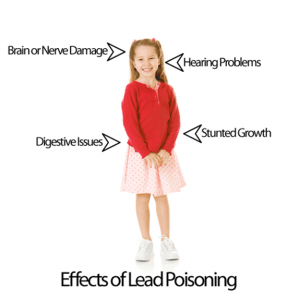Lead is a poison that affects virtually every system in the human body, and is particularly harmful to the developing brain and nervous system of fetuses and young children. Children under 6 are at greater risk for lead poisoning, because they are more likely to put their hands, toys, and other things into their mouths, which can cause them to ingest lead dust or lead paint chips.
Lead-based paint is the main source of childhood lead poisoning, and can be found in homes built before 1978. Lead poisoning is and continues to be the number one health hazard for children in Maine and across the country. Forty percent of children with lead poisoning live in five major cities in Maine: Lewiston/auburn, Bangor, Portland, Sanford, and Biddeford/Saco. Lead dust paint is barely visible but the effects can be detrimental. Lead poisoning in the Lewiston/Auburn Area is three times that of the State of Maine average.
Lead can have a very serious and permanent effect on a child’s growth and development.
Lead can cause:
- Learning disabilities
- Behavioral problems
- Hearing damage
- Language or speech delays
- Lower intelligence/ reduced IQ
Lead poisoning remains one of the most common and preventable pediatric conditions in the United States. The prevalence of elevated blood lead levels is much higher among newly settled refugee children in the United States. Lewiston-Auburn has the highest rate of childhood lead poisoning in the State of Maine.
Resources:
Maine CDC Childhood Lead Poisoning Prevention:
http://www.maine.gov/dhhs/mecdc/environmental-health/eohp/lead/index.shtml
City Resources:
